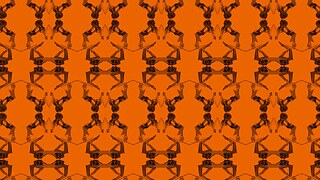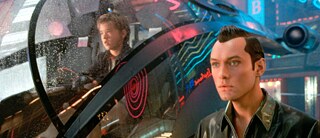Fantasies, power and humanity
Artificial intelligence has been depicted in film for decades. It embodies the tension in our societies between interest, enthusiasm, scepticism and anxiety about the technologies we have created and which surround us every day. Hollywood imagery exists alongside productions in all types of genres, from sci-fi to melodrama, that depict machines controlling the most intimate aspects of our lives.
This year’s Melbourne International Film Festival (MIFF) made considerable headlines and not just because it reinvented itself as an online format called MIFF 68½ due to COVID-19. The film The Trouble with Being Born (2020) by Austrian director Sandra Wollner was withdrawn by the festival management after the story, in which a childlike android replaces the missing daughter of a single father, was deemed to have paedophilic undertones.
This contemporary cinematic contribution to the story of artificial intelligence (AI) is the latest in a long line of films featuring supercomputers, robots, androids, cyborgs, bots and avatars. AI crops up in a wide variety of genres and styles – from sci-fi and horror to thrillers, melodramas, cartoons and animations – which indicates its popularity and relevance in the global cultural imagination.
The way we imagine humanoid machines is undoubtedly influenced by American cinema. In Hollywood productions, artificial intelligence comes in all sizes, shapes and colours, appearing as our friends, enemies or superior forces to be reckoned with. Star Wars, in which the loveable and cheeky droids R2-D2 and C-3PO join Luke Skywalker and Han Solo in the fight against evil, is one of the most successful blockbuster series of all time. The franchise is constantly coming up with new fantastical stories about life beyond the Milky Way.
Cinema portrays dreams and nightmares that inspire us to achieve technological feats, while also fantasising about where such technologies could lead and raising questions about definitions, boundaries and the enhancement of human existence. Will we be overrun and overpowered by the cognitive abilities of our own creations? Is it possible to love a robot and do they reciprocate our feelings?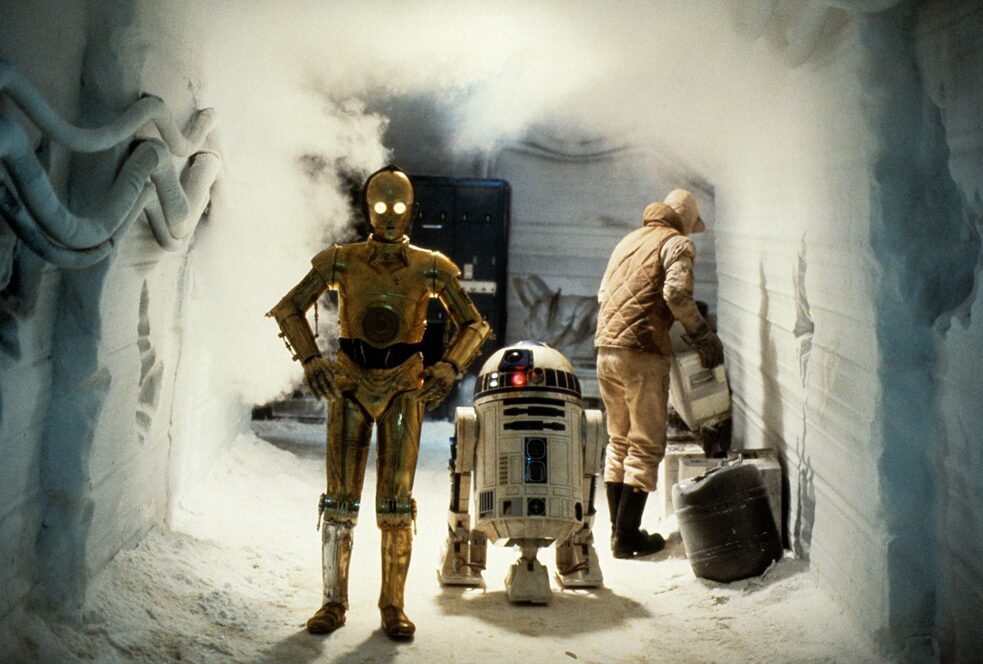 R2-D2 an C-3PO were depicted as loveable and cheeky droids in "Star Wars"
| Courtesy: Everett Collection / © Lucasfilm
R2-D2 an C-3PO were depicted as loveable and cheeky droids in "Star Wars"
| Courtesy: Everett Collection / © Lucasfilm
The soulless quality of autonomously operating systems was first examined in German cinema at the beginning of the 20th century. Paul Wegener’s Golem character (The Golem, 1915; The Golem and the Dancing Girl, 1917; The Golem: How He Came into the World, 1920) draws on a motif with Jewish and mythical heritage about a creature brought into existence by humankind that defies the will of its creators and turns against them.
A few years later the “fake Maria” unleashed chaos in Fritz Lang’s Metropolis (1927). This robotic character played by cinema icon Brigitte Helm and the film’s avant-garde urban architecture proved early sources of inspiration for the sci-fi genre, which plays out in the endless corridors and control rooms of spaceships. With its cool colour scales and symmetrical forms, Lang’s film sets forecast the domination of everything organic in favour of an existence of predictability, logic and efficiency.
In Stanley Kubrick’s 2001: A Space Odyssey, a dystopian vision of humankind’s evolution into machines, a group of scientists on a mission to Jupiter. The spaceship’s operations are controlled by HAL, a computer with a human personality. After HAL makes a mistake, the crew considers shutting him off. HAL subsequently cuts off the oxygen supply to several crew members while they are completing repairs outside the ship, thereby killing them.
European cinema of the 1960s and 70s explored the idea of intelligent systems and voiced fears about such systems gaining power and take over. It was the hot phase of the Cold War, which was characterised by “space race” between the USA and the USSR. Jean-Luc Godard’s Alphaville (1965) points to the moral abyss associated with this technological progress. The brainwashed residents of Alphaville, a city created by the cold-blooded Professor von Braun, are unfamiliar with concepts such as love and poetry, the past and the future. In a world whose rules are defined by the computer system Alpha 60, every type of emotion and irrationality are punishable by death. Filmed in the noir style and rich in contrast, the film also hints at the institutions and processes that made up the extermination machinery of the Holocaust.
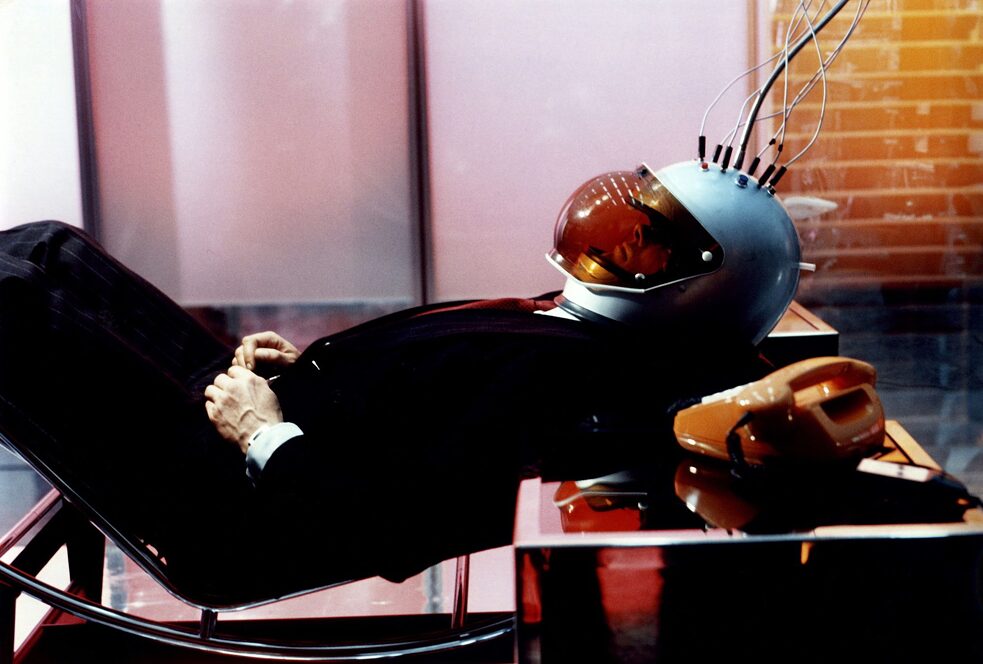 "World on a Wire" was a 1973 science fiction TV series from Germany
| © Fassbinder Foundation / Photo: Peter Gauhe / Archive: DFF Deutsches Filminstitut & Filmmuseum
The extravagant, four-hour West German production World on a Wire (1973) grapples with the vision of a society as a computer-simulated model that programs human behaviour. This film remains one of German cinema’s few contributions to science fiction and the only example of Rainer Werner Fassbinder’s work in this genre. Over the past few years World on a Wire experienced something of a renaissance and has influenced the spatial design of today’s virtual realities, including the Matrix created by the Wachowski brothers.
"World on a Wire" was a 1973 science fiction TV series from Germany
| © Fassbinder Foundation / Photo: Peter Gauhe / Archive: DFF Deutsches Filminstitut & Filmmuseum
The extravagant, four-hour West German production World on a Wire (1973) grapples with the vision of a society as a computer-simulated model that programs human behaviour. This film remains one of German cinema’s few contributions to science fiction and the only example of Rainer Werner Fassbinder’s work in this genre. Over the past few years World on a Wire experienced something of a renaissance and has influenced the spatial design of today’s virtual realities, including the Matrix created by the Wachowski brothers.
Although cyborg characters are primarily found in US cinema, they also appear in Latin American films as manifestations of social anxieties. Reproductive mechanisms and electronic networks are the subjects of films such as Cronos (1993), the debut of renowned Mexican director Guillermo de Toro, as well as La Sonámbula (1998) by the Argentinian filmmaker Ferdinando Spiner. In futuristic and dystopian settings, the cyborg serves as a metaphor for the disintegration of collective identities in neoliberal structures and is suggestive of economic exploitation and oppression under earlier dictatorships.
Meanwhile, in Japan, animated robot characters are endlessly popular – a fact which never ceases to surprise the robophobic Western world. The manga series Astro Boy (1952-1968) and Ironman 28 (1956) were the first in a flood of Japanese productions about android heroes, helpers and adventurers. For instance, in Hinokio (2005), a remote-controlled android helps the ten-year-old Satoru participate in everyday life again after he becomes wheelchair-bound and loses his mother in an accident.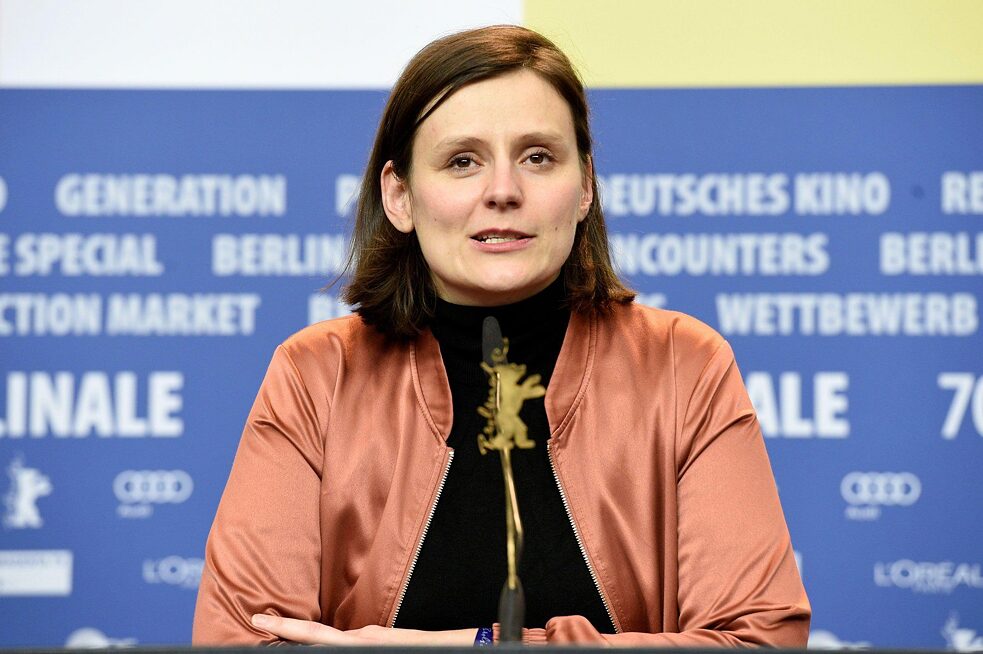 Sandra Wollner, the director of controversial film "The Trouble with Being Born"
| © dpa / Alamy Live News
Sandra Wollner, the director of controversial film "The Trouble with Being Born"
| © dpa / Alamy Live News
After decades of apocalyptic images and stories about rebellion against intelligent, destructive powers and co-existence with intelligent creatures from other galaxies, today’s fantasies and fears revolve around gender identities and sexual diversity. In Spike Jonze’s Her (2013), Theodore Twombly finds his virtual assistant Samantha to be a clever conversationalist and falls in love with her.
Will the technological possibilities and opportunities of the future focus on developing robots that can satisfy the intimate desires of consumers? The android character of Elli in the aforementioned The Trouble with Being Born is perfectly designed to meet the needs of her user. In the lonely existence of post-modern societies, the computer becomes an adequate partner, beyond any kind of moral judgement.
Learn more about Claudia Sandberg's views on the future of creative AI here.
This contemporary cinematic contribution to the story of artificial intelligence (AI) is the latest in a long line of films featuring supercomputers, robots, androids, cyborgs, bots and avatars. AI crops up in a wide variety of genres and styles – from sci-fi and horror to thrillers, melodramas, cartoons and animations – which indicates its popularity and relevance in the global cultural imagination.
The way we imagine humanoid machines is undoubtedly influenced by American cinema. In Hollywood productions, artificial intelligence comes in all sizes, shapes and colours, appearing as our friends, enemies or superior forces to be reckoned with. Star Wars, in which the loveable and cheeky droids R2-D2 and C-3PO join Luke Skywalker and Han Solo in the fight against evil, is one of the most successful blockbuster series of all time. The franchise is constantly coming up with new fantastical stories about life beyond the Milky Way.
Cinema portrays dreams and nightmares that inspire us to achieve technological feats, while also fantasising about where such technologies could lead and raising questions about definitions, boundaries and the enhancement of human existence. Will we be overrun and overpowered by the cognitive abilities of our own creations? Is it possible to love a robot and do they reciprocate our feelings?
 R2-D2 an C-3PO were depicted as loveable and cheeky droids in "Star Wars"
| Courtesy: Everett Collection / © Lucasfilm
R2-D2 an C-3PO were depicted as loveable and cheeky droids in "Star Wars"
| Courtesy: Everett Collection / © Lucasfilm
Pioneering AI films
There seems to be an endless supply of audio-visual representations of personified intelligence, digitalised parallel worlds, spaces and scenarios. Such depictions frequently contain references to films that are considered the classics of the AI theme.The soulless quality of autonomously operating systems was first examined in German cinema at the beginning of the 20th century. Paul Wegener’s Golem character (The Golem, 1915; The Golem and the Dancing Girl, 1917; The Golem: How He Came into the World, 1920) draws on a motif with Jewish and mythical heritage about a creature brought into existence by humankind that defies the will of its creators and turns against them.
A few years later the “fake Maria” unleashed chaos in Fritz Lang’s Metropolis (1927). This robotic character played by cinema icon Brigitte Helm and the film’s avant-garde urban architecture proved early sources of inspiration for the sci-fi genre, which plays out in the endless corridors and control rooms of spaceships. With its cool colour scales and symmetrical forms, Lang’s film sets forecast the domination of everything organic in favour of an existence of predictability, logic and efficiency.
In Stanley Kubrick’s 2001: A Space Odyssey, a dystopian vision of humankind’s evolution into machines, a group of scientists on a mission to Jupiter. The spaceship’s operations are controlled by HAL, a computer with a human personality. After HAL makes a mistake, the crew considers shutting him off. HAL subsequently cuts off the oxygen supply to several crew members while they are completing repairs outside the ship, thereby killing them.
European cinema of the 1960s and 70s explored the idea of intelligent systems and voiced fears about such systems gaining power and take over. It was the hot phase of the Cold War, which was characterised by “space race” between the USA and the USSR. Jean-Luc Godard’s Alphaville (1965) points to the moral abyss associated with this technological progress. The brainwashed residents of Alphaville, a city created by the cold-blooded Professor von Braun, are unfamiliar with concepts such as love and poetry, the past and the future. In a world whose rules are defined by the computer system Alpha 60, every type of emotion and irrationality are punishable by death. Filmed in the noir style and rich in contrast, the film also hints at the institutions and processes that made up the extermination machinery of the Holocaust.
 "World on a Wire" was a 1973 science fiction TV series from Germany
| © Fassbinder Foundation / Photo: Peter Gauhe / Archive: DFF Deutsches Filminstitut & Filmmuseum
The extravagant, four-hour West German production World on a Wire (1973) grapples with the vision of a society as a computer-simulated model that programs human behaviour. This film remains one of German cinema’s few contributions to science fiction and the only example of Rainer Werner Fassbinder’s work in this genre. Over the past few years World on a Wire experienced something of a renaissance and has influenced the spatial design of today’s virtual realities, including the Matrix created by the Wachowski brothers.
"World on a Wire" was a 1973 science fiction TV series from Germany
| © Fassbinder Foundation / Photo: Peter Gauhe / Archive: DFF Deutsches Filminstitut & Filmmuseum
The extravagant, four-hour West German production World on a Wire (1973) grapples with the vision of a society as a computer-simulated model that programs human behaviour. This film remains one of German cinema’s few contributions to science fiction and the only example of Rainer Werner Fassbinder’s work in this genre. Over the past few years World on a Wire experienced something of a renaissance and has influenced the spatial design of today’s virtual realities, including the Matrix created by the Wachowski brothers.
Cyborgs and other physical forms
While 1960s and 70s sci-fi cinema focused on supercomputers and non-physical presences depicted using distorted voices and rhythmically blinking lights, in the 80s new types of artificial intelligence hit the big screen. Audiences were introduced to the so-called cyborg, a symbiosis of organic substances and biomechatronical body parts, in the Star Trek series, Blade Runner (1982), Terminator (1984, 1991), Ex-Machina (2014) or Ghost in the Shell (1995, 2017). Self-regenerating and operationally flawless, the cyborg represents the evolution of the vulnerable human body to the perfect citizen: a technologically controlled, mechanical life form.Although cyborg characters are primarily found in US cinema, they also appear in Latin American films as manifestations of social anxieties. Reproductive mechanisms and electronic networks are the subjects of films such as Cronos (1993), the debut of renowned Mexican director Guillermo de Toro, as well as La Sonámbula (1998) by the Argentinian filmmaker Ferdinando Spiner. In futuristic and dystopian settings, the cyborg serves as a metaphor for the disintegration of collective identities in neoliberal structures and is suggestive of economic exploitation and oppression under earlier dictatorships.
Meanwhile, in Japan, animated robot characters are endlessly popular – a fact which never ceases to surprise the robophobic Western world. The manga series Astro Boy (1952-1968) and Ironman 28 (1956) were the first in a flood of Japanese productions about android heroes, helpers and adventurers. For instance, in Hinokio (2005), a remote-controlled android helps the ten-year-old Satoru participate in everyday life again after he becomes wheelchair-bound and loses his mother in an accident.
 Sandra Wollner, the director of controversial film "The Trouble with Being Born"
| © dpa / Alamy Live News
Sandra Wollner, the director of controversial film "The Trouble with Being Born"
| © dpa / Alamy Live News
Invasions of privacy
The development of sophisticated robots has long been the subject of research carried out in specially designed laboratories and, in the world of cinema, it continues to blur the line between man and machine. In the often-cited sci-fi drama Artificial Intelligence (2001), Steven Spielberg transports the audience to a future in which the human population has been decimated by climate catastrophes. The plot focuses on a mecha (humanoid robot) programmed with feelings and memories who serves as a substitute for a couple’s terminally ill child. The robot is the protagonist in this Hollywood version of Pinocchio, the story of the wooden boy who was loved and then cast away.After decades of apocalyptic images and stories about rebellion against intelligent, destructive powers and co-existence with intelligent creatures from other galaxies, today’s fantasies and fears revolve around gender identities and sexual diversity. In Spike Jonze’s Her (2013), Theodore Twombly finds his virtual assistant Samantha to be a clever conversationalist and falls in love with her.
Will the technological possibilities and opportunities of the future focus on developing robots that can satisfy the intimate desires of consumers? The android character of Elli in the aforementioned The Trouble with Being Born is perfectly designed to meet the needs of her user. In the lonely existence of post-modern societies, the computer becomes an adequate partner, beyond any kind of moral judgement.
Learn more about Claudia Sandberg's views on the future of creative AI here.
